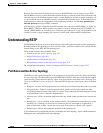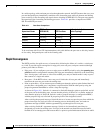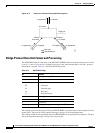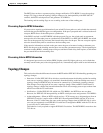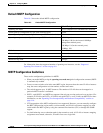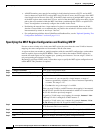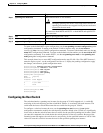
10-13
Cisco Systems Intelligent Gigabit Ethernet Switch Modules for the IBM BladeCenter, Software Configuration Guide
24R9746
Chapter 10 Configuring MSTP
Configuring MSTP Features
To return to the default MST region configuration, use the no spanning-tree mst configuration global
configuration command. To return to the default VLAN-to-instance map, use the no instance
instance-id [vlan vlan-range] MST configuration command. To return to the default name, use the no
name MST configuration command. To return to the default revision number, use the no revision MST
configuration command. To re-enable PVST+, use the no spanning-tree mode or the spanning-tree
mode pvst global configuration command.
This example shows how to enter MST configuration mode, map VLANs 10 to 20 to MST instance 1,
name the region region1, set the configuration revision to 1, display the pending configuration, apply
the changes, and return to global configuration mode:
Switch(config)# spanning-tree mst configuration
Switch(config-mst)# instance 1 vlan 10-20
Switch(config-mst)# name region1
Switch(config-mst)# revision 1
Switch(config-mst)# show pending
Pending MST configuration
Name [region1]
Revision 1
Instance Vlans Mapped
-------- ---------------------
0 1-9,21-4094
1 10-20
-------------------------------
Switch(config-mst)# exit
Switch(config)#
Configuring the Root Switch
The switch maintains a spanning-tree instance for the group of VLANs mapped to it. A switch ID,
consisting of the switch priority and the switch MAC address, is associated with each instance. The
switch with the lowest switch ID becomes the root switch for the group of VLANs.
To configure a switch to become the root, use the spanning-tree mst instance-id root global
configuration command to modify the switch priority from the default value (32768) to a significantly
lower value so that the switch becomes the root switch for the specified spanning-tree instance. When
you enter this command, the switch checks the switch priorities of the root switches. Because of the
extended system ID support, the switch sets its own priority for the specified instance to 24576 if this
value will cause this switch to become the root for the specified spanning-tree instance.
Step 8
spanning-tree mode mst Enable MSTP. RSTP is also enabled.
Caution Changing spanning-tree modes can disrupt traffic because all
spanning-tree instances are stopped for the previous mode and
restarted in the new mode.
You cannot run both MSTP and PVST+ or both MSTP and rapid PVST+
at the same time.
Step 9
end Return to privileged EXEC mode.
Step 10
show running-config Verify your entries.
Step 11
copy running-config startup-config (Optional) Save your entries in the configuration file.
Command Purpose



